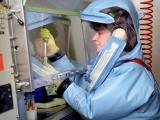Nov 9, 2010 (CIDRAP News) The safeguards designed to keep diseased animals from being imported into the United States have sizable holes, and the federal agencies that oversee those safeguards need to coordinate better to improve them, says a new report from the Government Accountability Office (GAO).
The GAO, Congress's investigative agency, says the agencies that deal with imported animals are collaborating to try to reduce risks but are hampered by problems such as unclear roles and responsibilities and incompatible data systems.
Agencies that regulate the importation of live animals include the Animal and Plant Health Inspection Service (APHIS) in the US Department of Agriculture (USDA); the Fish and Wildlife Service (FWS) in the Department of Interior (DOI); the Centers for Disease Control and Prevention (CDC) in the Department of Health and Human Services (HHS); and Customs and Border Protection (CBP) in the Department of Homeland Security (DHS).
The report says 32 million animals were imported under APHIS regulations in fiscal year 2008, the latest data available, and 177 million animalsmostly fishwere imported under FWS rules in fiscal year 2009.
To study the system for preventing importation of animal diseases, the GAO conducted surveys of animal health experts, interviewed agency officials, and examined the scientific literature. The general conclusion was that the laws and regulations governing live-animal imports have "gaps that could allow the introduction and spread of zoonotic diseases and diseases affecting wildlife," the GAO says.
"In particular, while APHIS has regulations in place to protect agricultural animals from the risk of diseases in live animal imports, CDC does not fully use its statutory authority to prevent the importation of live animals that may pose a risk of zoonotic diseases, and FWS does not generally restrict the entry of imported wildlife that may pose disease risks," the report states.
The CDC has regulations to bar importation of animals that may pose a previously identified disease risk to humans, but it has no process for identifying risks from some emerging diseases linked to imported animals, the GAO says. Enforcement of the CDC regulations is the responsibility of other agencies, including APHIS, CBP, and FWS, the report notes.
As an example of gaps in the CDC approach to imported animal diseases, the report says the agency has barred rodents from Africa since the monkeypox outbreak of 2003, but rodents from other places can be imported without any screening for diseases.
Fifty of 55 experts who responded to a GAO survey said the CDC should have more authority to restrict animal imports, perhaps by assessing disease risk by species and country.
The GAO reports that the CDC actually issued a notice of proposed rule-making in 2007 to address these concerns. The agency is currently analyzing comments on the notice and plans to propose new rules next year.
The FWS, meanwhile, "has not generally emphasized preventing the introduction of disease through importation," as it has focused more on the threat of invasive species and on illicit trade in endangered species, according to the GAO. But the agency has taken some steps to address gaps in its regulation of animal imports, including a comprehensive review, ordered in January, of statutory authorities and regulations concerning invasive species.
The four federal agencies are collaborating in several areas to address the threat of imported animal diseases: strategic planning, joint strategies, written procedures, leveraging of resources, and sharing of data, the GAO says. But collaboration is hampered by "different program priorities and unclear roles and responsibilities." In particular, no single body has "comprehensive responsibility for the zoonotic and animal disease risks posed by live animal imports."
In addition, the agencies have "largely incompatible data systems," the GAO found. CBP is working on a system to give the agencies full access to information on incoming shipments of animals, but no completion date has been set, and the agencies have not yet jointly determined exactly what kinds of data the system should provide.
The GAO recommends that the secretaries of the relevant federal departments (USDA, HHS, DHS, and DOI) develop a strategy to address the barriers to agency collaboration in the realm of imported animal diseases and to "jointly determine data needs to effectively oversee imported animals."
USDA, DOI, and DHS officials reviewed a draft of the report and generally agreed with its findings and recommendations. HHS officials provided only technical comments, the report says.
See also:
Full text of GAO report "Agencies need better collaboration to reduce the risk of animal-related diseases" (88 pages)


















